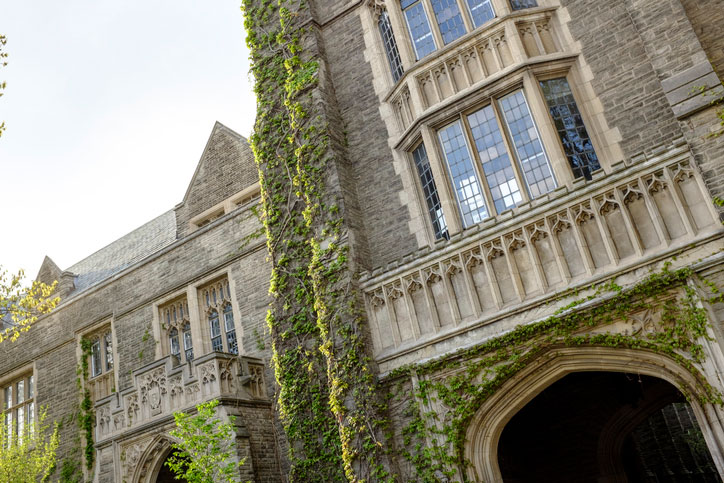What Colleges Are in Missouri That Has Liberal Arts Programs

Although almost every four-year university in the United States offers an education that is rooted in the liberal arts tradition, they aren't all considered liberal arts universities. In the most general sense, liberal arts colleges are institutions that don't have a distinct vocational or professional rails focus, only instead offer a more than interdisciplinary didactics that covers many fields.
Only there'due south really no precise definition for what a liberal arts higher is or is not. The term has taken on a life of its own as a kind of shorthand to draw schools that offer a well-rounded by generally less technically focused higher experience. At that place'southward no difficult and fast rule for how to use the term liberal arts college, but in the truest sense, these schools can always be recognized past a few traits:
- Strong Humanities Courses
- Encourage Creativity and Exploration
- Personal Connections Are Emphasized
- Small Class Sizes
The term liberal arts higher gets thrown around a lot in higher education, merely what does "liberal arts college" mean?
You may already know that liberal arts is a broad term. It encompasses a broad range of fields, from English to psychology to economics, while also describing a particular philosophy of instruction: a commitment to inquiry, rational discussion, and creative trouble-solving.
And you're already familiar with a liberal arts education, considering that's exactly what most American Thousand-12 schools offer, so you've actually been getting an educational activity in that tradition from the time y'all were in kindergarten. A broad range of classes in different subjects is standard. Teaching kids to call up is the main mission, not just cramming facts. The same is true at the college level.
What Does Liberal Arts College Hateful?
So, if you've had a liberal arts educational activity most of your life, you may exist wondering what does liberal arts college mean, really? Artistic thinking will serve yous well as y'all dive into it…
A Liberal Arts College Has Strong Humanities Courses
Liberal arts wouldn't exist liberal arts without the humanities. These academic disciplines cover the classics, including:
- Classical Civilization
- Literature
- Philosophy
- History
- Archeology
- Anthropology
- Religion
- Art
The departments that offer those courses at a liberal arts higher are typically some of the largest and most respected. While big research colleges might tend to treat them as box-checking exercises on the way to professional studies, a liberal arts higher makes humanities courses their métier.
Liberal Arts Colleges Encourage Creativity and Exploration
Teaching thinking skills is the primary goal at liberal arts schools, so expect to detect programs that force you to retrieve outside the box. You're likely to notice experimental approaches such as designing your own curriculum or an emphasis on experiential learning. Liberal arts schools often offer overseas learning experiences to encourage travel and exploration of other cultures.
Attitudes among instructors are some of the defining elements of what the liberal arts college experience is all well-nigh. You're less likely to detect your ideas and suggestions shot down, and more likely to have professors who encourage the exploration of original thought and creative ideas.
Although you'll go a lot of cross-disciplinary cognition thrust upon you lot, pedagogy isn't purely prescriptive at a liberal arts college.
All of this is designed to build conviction in your own critical thinking and reasoning skills. You'll receive a lot of back up when it comes to developing your own thoughts and judgements through your studies.
Discussion and Personal Connections Are Emphasized at Liberal Arts Colleges
The way that instructors approach their jobs is different at liberal arts schools. Lecture and didactic education styles are out; fostering a spirit of research and getting students to teach themselves is in.
That means developing real and personal connections with students, and encouraging give-and-take and argue. A liberal arts college is a place where you lot can look to engage non just with other students in your courses, merely also with faculty. In the halls, in classrooms, at the student union… yous can expect to run into engaging, interesting people and have fun conversations with them at a liberal arts higher.
This connection often extends well past graduation, besides. Alumni groups are tight and networks are far-flung and diverse. All those unlike interests take off in different professional directions, so you lot tin can count on your course reunions existence chock full of a lot of interesting stories from quondam classmates.
Small Class Sizes are Standard at a Liberal Arts Higher
 All those personal connections are fostered by class sizes that are smaller than boilerplate.Co-ordinate to 2019 information from the National Center For Education Statistics, the average ratio of students to faculty at public universities—most of which are not considered liberal arts colleges—is 15 to ane. At private non-profit universities—many of which are liberal arts colleges—that ratio is only x to 1.
All those personal connections are fostered by class sizes that are smaller than boilerplate.Co-ordinate to 2019 information from the National Center For Education Statistics, the average ratio of students to faculty at public universities—most of which are not considered liberal arts colleges—is 15 to ane. At private non-profit universities—many of which are liberal arts colleges—that ratio is only x to 1.
That means instructors are not spread as thin and have fewer students per grade and more than time per student to offering individual attention. And with fewer students per class, it too becomes easier for you lot to get to know your young man students.
All of these factors come together to pigment a picture of what a liberal arts college is today.
A Basic Checklist For Determining What'due south a Liberal Arts Higher—Probably
A liberal arts pedagogy will teach you pretty speedily to avoid speaking in absolutes. In the same mode, y'all won't discover some hard and fast rule most what a academy admittedly must accept in guild to qualify as a liberal arts higher. Instead, y'all tin can remember of it as a calibration, where some schools lean more in the direction of a liberal arts college.
You tin run down the checklist of the key characteristics of a liberal arts education to get a sense of where a schoolhouse might fall on that scale:
- A liberal arts college typically focuses on undergraduate education - While liberal arts schools may offer master of liberal arts degrees, most of their degree focus is likely to be at the bachelor'due south level, with some main's degrees offering avant-garde tracks building on undergrad curriculum. There volition be less emphasis on post-graduate studies and enquiry than in other schools.
- A liberal arts higher primarily grants traditional liberal arts degrees - Almost of those available's degrees will exist granted in humanities subjects, with the large ones typically beingness English, history, and languages. Most of those programs will grant Available of Arts versus Available of Science degrees. And many of the degrees conferred will exist truthful liberal arts degrees by name, roofing all these areas more broadly, as is the instance with a BLS or Bachelor of Liberal Studies.
- A liberal arts higher is likely to be a individual academy - Because of the costs of maintaining loftier-quality faculty and the privilege of offering unorthodox, non-professional programs, about liberal arts colleges are privately-owned, non-profit institutions.
- A liberal arts higher has small-scale student bodies - In keeping with the need for small class sizes and interpersonal relationships, the overall educatee population at liberal arts colleges tends to be small, often with only a couple thousand matriculating students.
- A liberal arts college has dedicated alumni and satisfied students - Because they are modest, liberal arts colleges are ofttimes elite. That makes for strong alumni associations and close, life-long ties amid students. Students also report being happier with their education at these universities.
- A liberal arts college tin can be uniquely focused on edifice a school community - High concentrations of creative people and open up-minded administrators tin make for some unusual campus traditions. Tinker Solar day at Hollins University, for instance, involves cancelling course on a random fall day and having virtually of the faculty, students, and staff hike up a nearby mountain for an impromptu picnic with outrageous costumes. Brown has the Naked Donut Run.
Columbia'southward Orgo Night has most of the student body invading Butler Library, where organic chemistry students traditionally study for their last exam, with the limited purpose of disrupting those studies with music and skits.
What does liberal arts college mean? The answer to this question is always, in a way, relative to the total landscape of college options. Those that put more focus on producing well-rounded, disquisitional thinkers and creative trouble solvers than on purely technical or professional track degrees could rightly be considered liberal arts colleges.
In the end, your liberal arts reasoning and assay skills are the perfect approach to answering the question: what is a liberal arts higher and what is not?
Source: https://liberalartsedu.org/faq/what-is-a-liberal-arts-college/
0 Response to "What Colleges Are in Missouri That Has Liberal Arts Programs"
Post a Comment